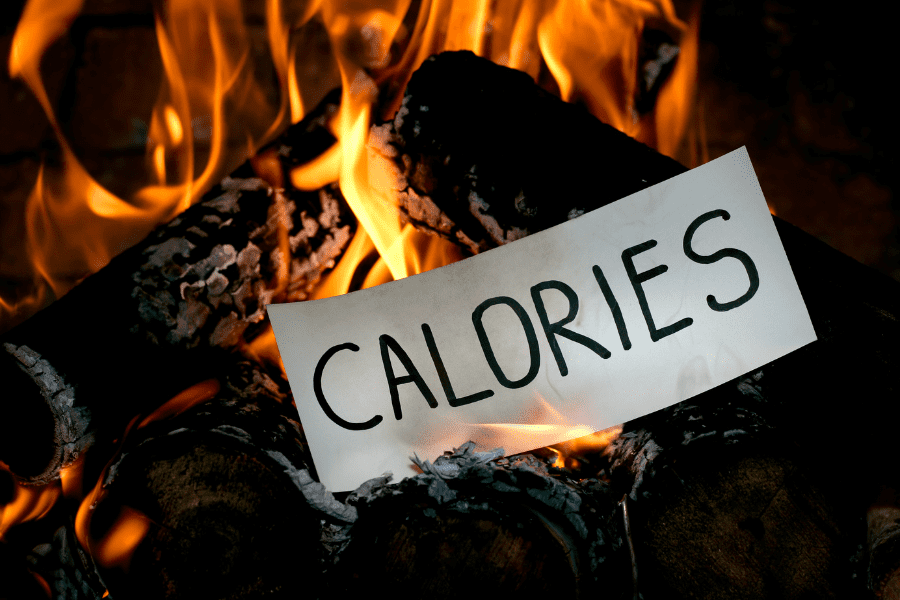Table of Contents
Understanding the relationship between different forms of exercise and calorie burn is crucial to achieving a healthy and fit lifestyle. For example, strength training, also known as resistance training, is often associated with building muscle and gaining strength. However, many individuals wonder whether strength training is effective for burning calories.
As highly qualified professionals in fitness and exercise science, we aim to explore the question that often arises in fitness enthusiasts’ minds: Does strength training burn calories?
In this article, we will delve into the truth behind the calorie-burning potential of strength training and unravel its impact on weight management.

Understanding the Calorie Burning Process
Before we dive into the specifics of strength training and its impact on calorie burn, let’s establish a solid foundation of knowledge regarding calories and their connection to weight management.
Calories serve as units of energy that our bodies utilise for various bodily functions, including physical activity. Therefore, when our calorie intake exceeds our expenditure, weight gain ensues, while burning more calories than we consume leads to weight loss.
Numerous factors influence the number of calories burned during exercise. These factors encompass our basal metabolic rate (BMR), exercise intensity, and muscle mass and metabolism. Allow us to provide an in-depth understanding of each of these factors.
Basal Metabolic Rate (BMR)
Our BMR refers to the calories our bodies burn at rest to sustain essential bodily functions such as respiration, circulation, and cell production. Even during periods of inactivity, our bodies continue to expend energy. It’s essential to recognise that BMR varies from person to person based on age, gender, weight, and genetic predisposition.
Exercise Intensity
The intensity of exercise is pivotal in the calories burned during a workout. High-intensity activities such as running or engaging in high-intensity interval training (HIIT) tend to result in a more significant calorie burn than low-intensity exercises like walking or gentle yoga.
Muscle Mass and Metabolism
Muscle mass significantly impacts our body’s metabolism. Muscles are metabolically active tissues that necessitate energy to maintain themselves. Consequently, individuals with higher muscle mass tend to have a higher metabolic rate, implying that they burn more calories even at rest. This is where strength training becomes pertinent, as it plays a pivotal role in building and preserving muscle mass, positively influencing overall calorie burn.

Does Strength Training Burn Calories?
Now that we have comprehensively understood calorie burning let’s address the core question: Does strength training burn calories?
Examining the Calorie Burn during Strength Training
It is undeniable that strength training does burn calories. However, the immediate calorie burn during a strength training session may not be as pronounced as that of cardiovascular exercises. Nonetheless, the long-term benefits of strength training make it a highly effective tool for calorie-burning and weight management.
Strength training focuses primarily on building and strengthening muscles by subjecting them to resistance. As we engage in exercises like weightlifting or bodyweight movements, our muscles contract and work against the resistance, leading to energy expenditure and calorie burn.
The Afterburn Effect and EPOC
One of the key factors contributing to calorie burn beyond the workout session is Excess Post-Exercise Oxygen Consumption (EPOC), commonly referred to as the afterburn effect. EPOC denotes the increased oxygen consumption that occurs after an intense exercise session.
Strength training, especially high-intensity workouts, can elicit a substantial afterburn effect. This is because, following an intense strength training session, our bodies require replenishment of oxygen stores and repair of damaged muscle tissue. These processes demand energy, resulting in a continued calorie burn at an elevated rate even after the completion of the workout.
Building Lean Muscle Mass for Increased Calorie Burn
One remarkable advantage of strength training is its ability to help build lean muscle mass. As mentioned earlier, muscle tissue is metabolically active and demands more energy to sustain itself than fat tissue. Therefore, the more lean muscle mass we possess, the higher our resting metabolic rate (RMR) will be, leading to increased calorie burn throughout the day.
When we engage in strength training exercises, we create microscopic damage to our muscle fibers. During the recovery process, these fibres repair and grow stronger, contributing to muscle growth. As our muscles adapt to the demands of consistent strength training, they become more efficient at utilising energy, increasing calorie burn.
Furthermore, strength training promotes the development of type II muscle fibers, also known as fast-twitch muscle fibers. These fibers are responsible for explosive movements and have a higher energy demand, leading to more significant calorie expenditure during strength training workouts.
Long-Term Impact on Calorie Burning
Strength training offers more than just immediate calorie burn; it has a lasting impact on calorie burning and weight management. While cardiovascular exercises primarily burn calories during the workout itself, strength training provides a sustainable approach to calorie burn.
Our metabolic rate increases as we build lean muscle mass through strength training. This means that even when we’re not exercising, our bodies continue to burn more calories at rest than individuals with lower muscle mass. Consequently, strength training significantly affects calorie burning, contributing to weight management and overall energy balance.

Designing an Effective Strength Training Routine for Calorie Burning
Now that we understand the calorie-burning potential of strength training let’s discuss how to design an effective routine to maximise our calorie burn.
Choosing the Right Exercises for Calorie Burn
To optimise calorie burn during strength training, we should focus on compound exercises that engage multiple muscle groups simultaneously. However, these exercises require more energy and result in higher calorie expenditure. Examples of compound exercises include squats, deadlifts, lunges, bench presses, and pull-ups.
Incorporating High-Intensity Interval Training (HIIT)
Incorporating HIIT into our strength training routine can further enhance calorie burn. HIIT involves alternating between short bursts of intense exercise and brief recovery periods. This approach increases the intensity of our workouts and keeps our heart rate elevated, leading to more significant calorie expenditure.
Recommended Repetitions, Sets, and Rest Periods
To maximise calorie burn, we should aim for a moderate to high number of repetitions (8-15 repetitions) and multiple sets (3-5 sets) per exercise. This range promotes muscular endurance and increases overall energy expenditure.
We should keep our rest periods relatively short (30-60 seconds) between sets to maintain an elevated heart rate and metabolic demand. This approach creates a more challenging workout environment, resulting in greater calorie burn.
Incorporating Strength Training into Your Fitness Routine
To fully harness the benefits of strength training for calorie burn, it’s crucial to establish a consistent and well-rounded fitness routine. Here are some recommendations:
Frequency and Duration:
Aim for at least two to three weekly strength training sessions. This frequency allows for proper muscle recovery while stimulating muscle growth and calorie burn. Each session should last 45 minutes to an hour, including warm-up and cool-down periods.
Combining Strength Training with Other Forms of Exercise
While strength training is effective for building muscle and burning calories, incorporating cardiovascular exercises such as running, cycling, or swimming can further enhance overall fitness and calorie expenditure. Strive for a balanced approach by combining strength training and cardiovascular exercises in your routine.

Conclusion
As highly qualified professionals, we can confidently say that strength training burns calories. While the immediate calorie burn during strength training may not be as high as that of cardiovascular exercises, the long-term effects on metabolism, muscle growth, and the afterburn effect make it an integral component of any effective fitness program.
By incorporating strength training into youur routines, you experience the physical benefits of increased calorie burn and weight management, improving overall strength, enhancing bone density, and optimising body composition.
In addition, developing lean muscle mass through strength training leads to a higher resting metabolic rate, resulting in increased calorie burn even during rest periods.
To maximise the calorie-burning potential of strength training, it is recommended to focus on compound exercises that engage multiple muscle groups simultaneously. Including HIIT intervals within your strength training sessions can elevate the intensity and calorie expenditure.
Aim for moderate to high repetitions and sets, with shorter rest periods, to maintain an elevated heart rate and metabolic demand.
Consistency and progression are key in strength training. Gradually increasing the weights and intensity over time to challenge your muscles and stimulate growth and calorie burn.
Strive to include two to three strength training sessions per week, complemented by cardiovascular exercises for a well-rounded fitness routine.
We strongly encourage you to consult with a fitness professional or exercise specialist to tailor a strength training program that aligns with your individual goals, abilities, and any specific considerations you may have.
So, seize the opportunity to unleash the incredible calorie-burning power of strength training and embark on a journey to a stronger, healthier you.

Frequently Asked Questions
How many calories does strength training burn?
When it comes to the exact number of calories burned during strength training, it can vary based on factors such as exercise intensity, duration, and individual characteristics. However, on average, a 30-minute strength training session can on average burn approximately 100-200 calories.
It’s important to note that the calorie burn continues beyond the workout due to the afterburn effect and the increased metabolic rate associated with building lean muscle mass.
Is strength training as effective as cardio for calorie burning?
While cardiovascular exercises such as running or cycling are known for their immediate calorie-burning effects, strength training offers unique long-term benefits.
While the calorie burn during a strength training session may not be as high, it helps build lean muscle mass, which increases the resting metabolic rate and leads to more significant calorie burn throughout the day.
To maximise overall calorie burn, a combination of both strength training and cardiovascular exercises is recommended.
Does building muscle through strength training increase metabolism?
Yes, building muscle through strength training can increase metabolism. This is because muscles are metabolically active tissues, requiring more energy (calories) to maintain themselves than fat tissue.
So, as you engage in strength training and build lean muscle mass, your resting metabolic rate (RMR) increases. This means that even at rest, you’ll burn more calories.
So, strength training not only helps you burn calories during exercise but also boosts your metabolism in the long run.
What is the afterburn effect in strength training?
The afterburn effect, scientifically known as Excess Post-Exercise Oxygen Consumption (EPOC), refers to the increased calorie burn after an intense exercise session, such as strength training.
During strength training, your body utilises oxygen to replenish energy stores, repair muscle tissue, and restore various physiological processes.
This increased demand for oxygen post-workout leads to an elevated metabolic rate, resulting in continued calorie burn for hours after you’ve finished exercising.
How often should I include strength training in my fitness routine to maximise calorie burn?
To maximise calorie burn and overall benefits, you should include strength training in your fitness routine at least two to three times per week. This frequency allows for adequate recovery while stimulating muscle growth and calorie expenditure.
Remember, consistency is critical. Gradually increase the intensity and weights to continue challenging your muscles and promoting ongoing calorie burn.
Combining strength training with cardiovascular exercises is important to achieve a well-rounded fitness routine and enhance overall calorie expenditure

